Multidisciplinary inquiry-based investigation learning using an ex ovo chicken culture platform: role of vitamin a on embryonic morphogenesis
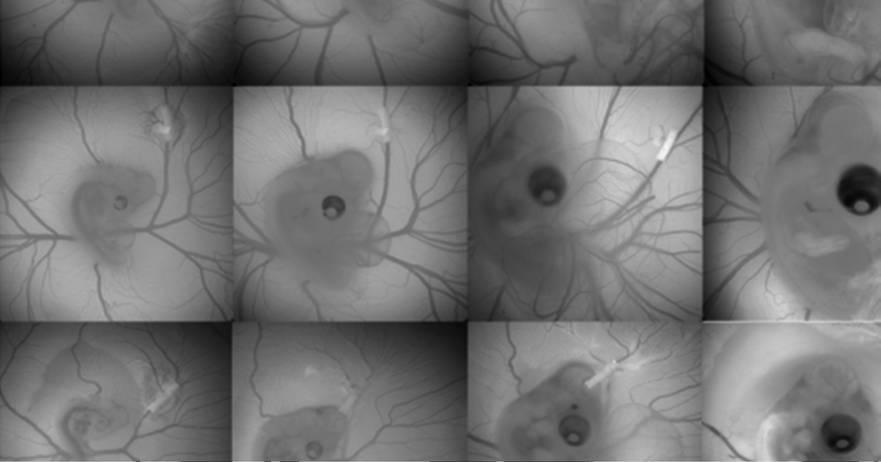
I n q u I r y &
Multidisciplinary Inquiry-Based
Learning Using an Ex Ovo
Chicken Culture Platform:
Role of Vitamin A on
Embryonic Morphogenesis
PhiliP R. Buskohl, Russell A. Gould,
susAn CuRRAn, shivAun d. ARCheR,
JonAthAn t. ButCheR
has been correlated with increased risk of congenital defects of
Embryonic development offers a unique perspective on the function of many
newborns (Rothman et al., 1995). Furthermore, the increased use
biological processes because of embryos' heightened sensitivity to environmental
of RA for medicinal purposes, such as treatment of acne (Tretinoin),
factors. This hands-on lesson investigates the effects of elevated vitamin A on
underscores the importance of clarifying the role of RA in formation
the morphogenesis of chicken embryos. The active form of vitamin A (retinoic
of birth defects.
acid) is applied to shell-less (ex ovo) cultured chick embryos, which are highly
The chick embryo is an excellent animal model in which to study
accessible and intrinsically spawn inquiry. The student activities mirror the
human morphogenesis of the heart, limbs, and eyes (Davey & Tickle,
scientific research process, including review of scientific literature, hypothesis
2007). Advantages of using the chick embryo for research include
formation, experimental design, interpretation of data, and re-evaluation of the initial hypothesis. This exercise supports instruction on developmental biology,
short development times, no maternal sacrifice, and ease of access
biophysics, animal research, and experimental design and is motivated by a clini-
for observation and treatment administration. Shell-less (ex ovo)
cally relevant health issue.
chick culture furthers this access by allowing real-time observation of the whole chick and its complement of extra-embryonic vascu-
Key Words: Retinoic acid; inquiry; embryo; developmental biology; biophysics;
lature. Ex ovo culture is an intrinsically inquiry-based classroom
vitamin A.
activity, in that the natural response of students is to ask "How can a chick embryo develop without a shell?" This activity engages that enthusiasm by exploring the role of vitamin A in development and
Congenital defects occur in 2.5% of all near- or full-term babies
the negative consequences of vitamin A excess. The teaching activi-
(Dolk et al., 2010). These malformations can affect multiple body
ties include an interactive background of RA scientific literature,
systems and are caused by both genetic and
hypothesis-driven experiments, hands-on
environmental factors. Chromosomal rear-
ex ovo culture with RA-treated embryos, sys-
rangements or local mutations within the
The chick embryo is an
tematic measurement of growth, and interpre-
genome can disrupt normal development,
tation of data in the context of the reviewed
such as with Down and Patau syndromes.
excellent animal model
literature. This exercise supports instruction
Environmental factors are chemical, molecular,
in developmental biology, molecular signaling,
in which to study human
and mechanical stimuli that can guide or mis-
animal research, and experimental design and
direct embryonic development. Common neg-
is motivated by a clinically relevant health issue
ative environmental factors include maternal
using current scientific research.
substance abuse, pollutants, nutritional defi-ciencies, and/or medications. In this exercise, we investigate the
J reparing for the Study
role of a nutritional environmental factor, vitamin A metabolite, in
Materials & Methods
directing embryonic chicken development.
Retinoic acid (RA) is the active form of vitamin A and has been
• Fertilized white Leghorn chicken eggs (local poultry farm)
correlated with severe congenital defects at both surplus and defi-
• Egg incubator and rocker (HovaBator, GQF Mfg., $60–100)
cient levels of maternal consumption (Zile, 2010; Ackermans et al.,
2011). Retinoic acid regulates cell differentiation, proliferation, and
developmentally related gene expression through interactions with RA receptors located on the DNA (Lanska, 2010). The specific RA
• Rubber bands (no. 16, 2.5 inches)
signaling mechanisms for tissue morphogenesis are still an active
• Rubber gloves and safety glasses
area of research. Excessive consumption of vitamin A supplements
• 9-oz. plastic cups (diameter 3 inches)
The American Biology Teacher, vol. 74, no. 9, pages 636–643. iSSn 0002-7685, electronic iSSn 1938-4211. 2012 by national association of biology Teachers. all rights reserved. request permission to photocopy or reproduce article content at the university of california Press's rights and Permissions Web site at www.ucpressjournals.com/reprintinfo.asp. Doi: 10.1525/abt.2012.74.9.7
The american biology Teacher
volume 74, no. 9, november/December 2012

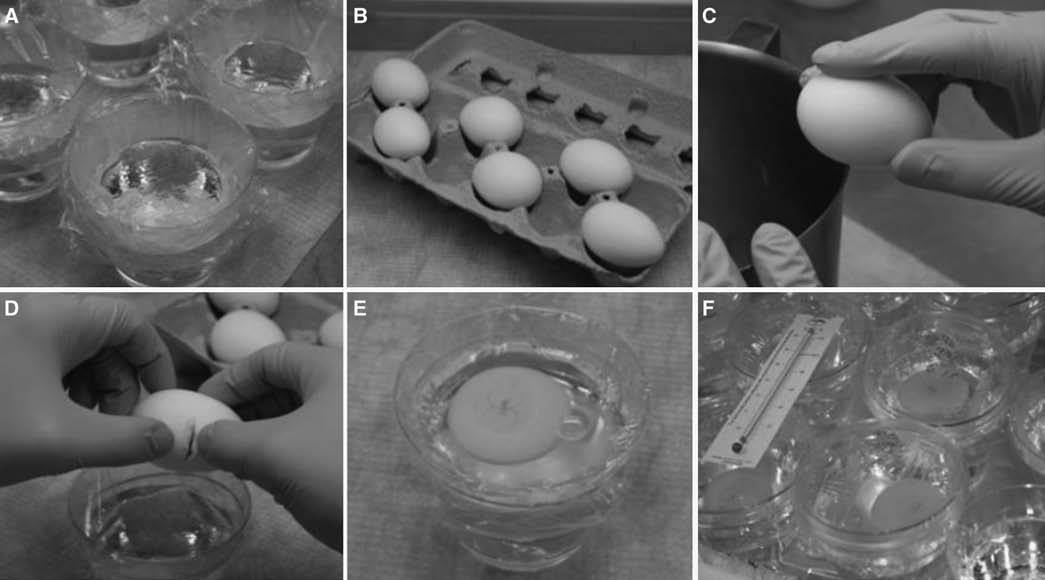
• 100-mm-diameter Petri dish
water. Cut about a 20 × 20 cm (8 × 8 inch) square of cling wrap
• Whatman filter paper, size 3
and place loosely inside each cup. Cling wrap should be in contact with water and form a loose hammock. Secure cling wrap to the cup
• 1.5-mL centrifuge tubes (optional)
with a rubber band (Figure 1A). Spray the plastic wrap with 70%
ethanol to prevent contamination. Remove eggs from incubator
• All-trans retinoic acid (Sigma-Aldrich R2625, $30)
after 72 hours of incubation. Sterilize eggs by spraying the surface
• Dimethyl Sulfoxide (DMSO, <10 mL)
with 70% ethanol. Lay the eggs horizontally on an egg carton for 1–2 minutes to allow the embryo to rotate (Figure 1B). Using a
• USB Microscope Veho VMS-100 ( $70) or alternative large
sharp edge (like the edge of a metal bucket or a glass beaker), tap
working distance scope
the egg gently until there is a small dent on the underside of the egg
Safety: Retinoic acid and DMSO should be handled with gloves
(Figure 1C). Put thumbs in opposite sides of the dent and open the
and safety glasses.
shell directly above the hammock (Figure 1D). The entire yolk, egg white, and embryo should fall into the hammock softly (Figure 1E).
Preparation of Incubator & Chick Embryos
If the embryo is not on the top side of the yolk, gently rotate the
Fertilized white Leghorn chicken eggs should be obtained from a
egg yolk with fingers (using gloves). Place a 100-mm-diameter Petri
local poultry farm. These fertilized embryos can be stored in a cooler
dish on top of the cup to seal the embryo. Transfer the embryo
maintained at 13°C (55°F) for up to 3–4 days until ready for use.
back into the incubator, set at 37°C, with a water cup to maintain
Prior to the start of your activity, clean out the incubator with soap
humidity (Figure 1F). Observe embryos as long as you would like
and water to remove contaminants. Dilute bleach or 70% ethanol
or as directed by the activity. We recommend that the students per-
can be used to sterilize the incubator. Line the base of the incubator
form the ex ovo culture under close supervision of an instructor or
with aluminum foil for easy clean-up and place the thermometer
teaching aid.
inside. Preheat the incubator to 37°C (99°F) and let stand 1 hour to confirm constancy of temperature. Place eggs blunt-side-up in the
Motivate Study & Discuss Background
incubator and turn on the rocker to start incubation (day 0). Include
Before investigating the effect of vitamin A on the embryonic chick,
a three-quarters-full 9-oz. cup of water inside the incubator to main-
it is important to motivate this study. Using the information out-
lined in the introduction, attempt to connect the overuse of vitamins and/or congenital birth defects with the students' experience with or
Ex Ovo Culture of Chick Embryos
perceptions of the issue. We found that this was best done through
After 72 hours (day 3), prepare hammocks for ex ovo culture
a brief but interactive large-group discussion. In addition, we rec-
(Figure 1). Fill three-quarters of each 9-oz. plastic cup with warm
ommend discussing normal embryonic development, particularly
Figure 1. Step-by-step ex ovo culture technique. (A) Prepare hammocks in plastic cups. (B) Lay eggs on blunt side to prep for
cracking. (C) Use sharp edge to create narrow crack on center of egg. (D) Carefully open eggshell directly above hammock and
cup. (E) Rotate embryo to top side of egg yolk. (F) Place in incubator at 37°C (99°F).
The american biology Teacher
embryonic morPhogeneSiS
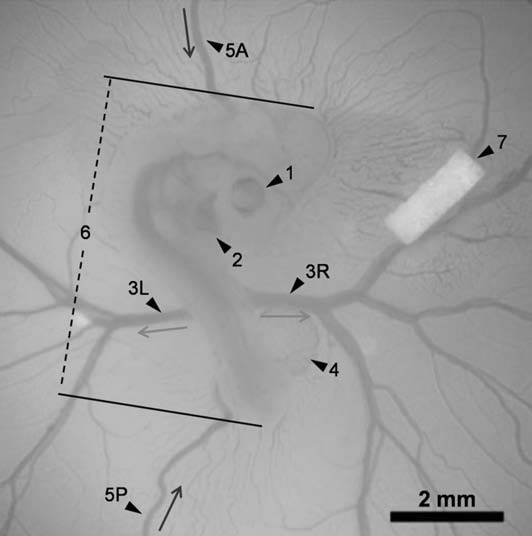
pertaining to chick development (Hamburger and Hamilton embryo
3. What does this excerpt indicate about the role of vitamin A in
atlas images provided in the supplement and/or online at http://
www.butcherlab.com).
4. The authors indicate that there is a "contradiction" in the human
Sufficient background information is needed to further place
data. What are the contrary/conflicting data?
excess vitamin A exposure in context and facilitate the students'
5. Why is the contradiction important to settle?
hypothesis formation. The students were given excerpts from intro-
6. What are the animal models for vitamin A research mentioned
duction sections of scientific and medical journal articles to analyze.
Field-specific literature was paraphrased to increase the readability of the excerpts. With each excerpt, we included a series of questions
7. Why are animal models important for this research?
that assessed reading comprehension and the acquisition of scientific
8. Why are different animal species important for this research?
concepts. Although reading technical literature can be difficult for students, completion of the exercise empowered the students and
broke down the false notion that scientific research can be under-
After reading the background material and discussing it as a class,
stood only by scientists. The exercise is similar to scientific reading-
divide the students into groups of three or four to prepare for the
comprehension questions on many standardized tests. It can also
experiment. Ask each group to formulate and record a hypothesis
be used as a graded activity, which provides early feedback for both
on what will happen when RA is applied to the vasculature network
student and teacher on the progress of the project. We recommend
of the ex ovo cultured embryo as compared to a normal embryo.
small groups of two or three students, preferably with a range of
Remind the students to develop a testable hypothesis, considering
ability, for this exercise. An initial read-through as a large group can
ahead of time which metrics they will use to evaluate the hypothesis.
remove any class-wide gaps in understanding. An example excerpt
In this module, embryo tip-to-tail length and eye diameter were the
and questions are shown below, and additional excerpts can be found
two morphological parameters used to compare between treatments.
"Tip-to-tail length" is defined as the longest line drawn between any two points in the embryo (Figure 2). Other measurement ideas
Background Information Example
include wing bud length, limb bud length, embryo area, heart rate,
Read the following excerpt from Ritchie et al. (2003) and answer the
and vasculature branching.
Example Hypothesis & Proposed Metrics
Vitamin A is an essential nutrient required
We hypothesize that excess vitamin A administered to the embryo
for normal embryonic development. Both
vasculature will affect the entire embryo and will result in stunted
an excess and deficiency during gesta-tion will result in abnormalities. Vitamin A (in its more common metabolic form, retinoic acid [RA]) is teratogenic when orally administered to pregnant rats, mice, hamsters, guinea pigs, rabbits and dogs. The induced malformations occur in all body systems including the central nervous system (CNS), the face, the cardiovascular system (ventricular septal defect, aortic arch anomalies), the limbs, the urogenital system, the respiratory system, and the gastrointestinal system. […] The ques-tion then arises, would similar malforma-tions be induced in humans exposed to RA? Teratogenic outcomes have reportedly been associated with exposures >40,000 IU [IU – international unit of biological activ-ity] or >10,000 IU. Equally reports have also suggested that supplemental RA intakes of <10,000 IU have no increased risk of major malformation. This contradictory data in humans highlights the importance of labo-ratory animal data in risk estimation.
Background Questions to Help with Hypothesis
Figure 2. Image of chick embryo in ex ovo culture at 4.5
1. List the stages of chick embryonic development and illustrate
days of incubation. Annotations: 1 = eye, 2 = heart, 3L = left
normal morphology.
vitelline arterty, 3R = right vitelline artery, 4 = chorioallantoic
2. List the reported body systems that are affected by vitamin A
membrane, 5A = anterior vitellene vein, 5P = posterior vitellene
excess during development.
vein, 6 = tip-to-tail length, and 7 = RA filter paper.
The american biology Teacher
volume 74, no. 9, november/December 2012
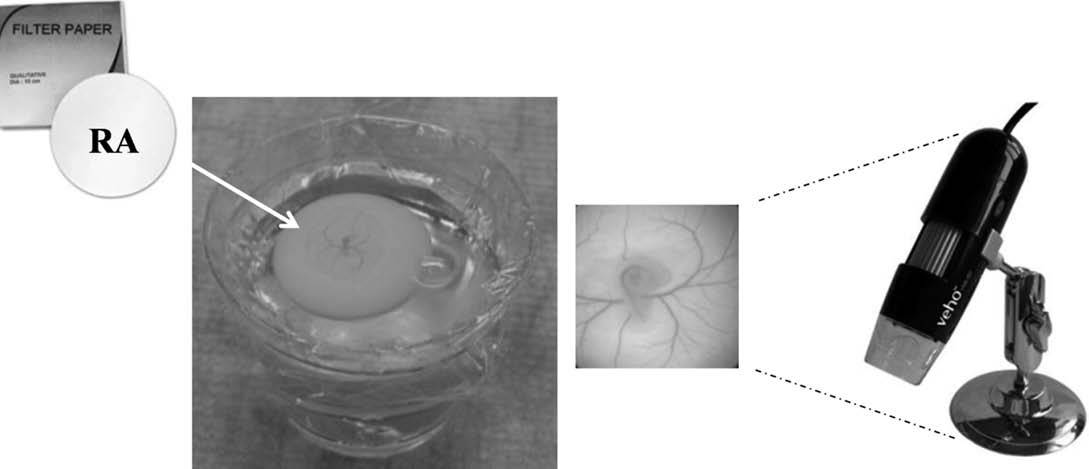
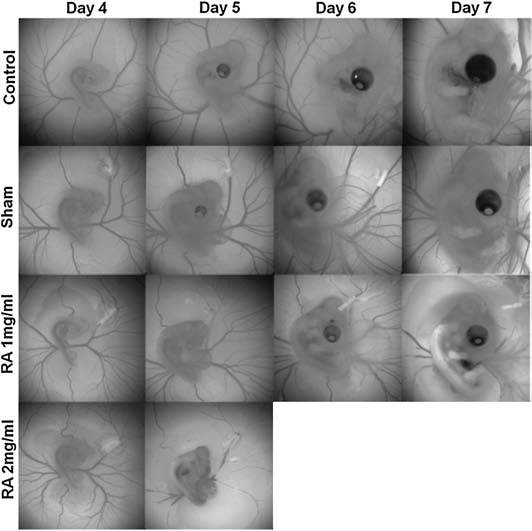
Figure 3. Experimental design consists of soaking filter paper in different concentrations of retinoic acid (RA) and placing it on the
embryonic vasculature. Following several days of incubation, a USB microscope can capture the downstream effects on development.
growth and reduced eye size. We will use tip-to-tail length as a metric
edu/embryo.php. Hand measurement using a caliper or ruler is a
of embryo growth and directly measure eye diameter.
viable alternative. Finally, record the measurements in tables for
Control experiments are an essential component of any well-
each metric (Figure 5).
designed scientific study. Spend a brief but intentional time explaining the types and purpose of controls with the students.
Analysis & Interpretation of RA Treatment Results
Solicit their assistance in identifying the most appropriate controls
An essential part of the scientific process, and often the most chal-
for this study. We recommend two controls, an untreated group
lenging, is to quantitatively analyze and correctly interpret the
(standard control) and a filter paper with DMSO only (sham con-trol). The standard control will provide the benchmark of normal development to compare with RA treated, and the sham control to verify that the effects observed are not due to the filter paper or the RA solvent, DMSO.
J onducting the Investigation
Environment Perturbation Study – Addition of
Vitamin A (Retinoic Acid)
From previous dose-dependent and temporal responses, we have
determined that an RA concentration of 1 mg/mL applied at day 4
of incubation induces morphological changes by day 7 of incuba-
tion. We recommend that the teacher mix the RA treatment and
administer it to the embryo. The RA and DMSO should be handled
with gloves and safety glasses. Cut the Whatman filter paper into
punches or strips 2–5 mm in diameter. Dilute 1 mg of RA in 1 mL
of DMSO in a 1.5-mL tube. Place the filter-paper sections in the
1.5-mL tube and let soak for 10–15 minutes. Using forceps, remove
the filter paper from the RA solution and place it on the ex ovo cul-
ture. We suggest placement of the filter paper on the right side of
the embryo, within the vasculature (Figure 2). Capture images of
the embryo and vasculature sequentially at day 4, day 5, day 6, and
day 7 using the USB-microscope (Veho VMS-100; Figures 3 and 4).
Measure the predetermined metrics of tip-to-tail length and eye
Figure 4. Retinoic acid perturbation study data set. Array of
diameter from these images using the open-source software ImageJ
ex ovo chick images across treatment and over time. The RA
(National Institutes of Health; http://rsbweb.nih.gov/ij/). Simple
treatment stunted embryo development and even resulted in
instructions for ImageJ are available at http://climb.bme.cornell.
embryo lethality at higher dosages.
The american biology Teacher
embryonic morPhogeneSiS
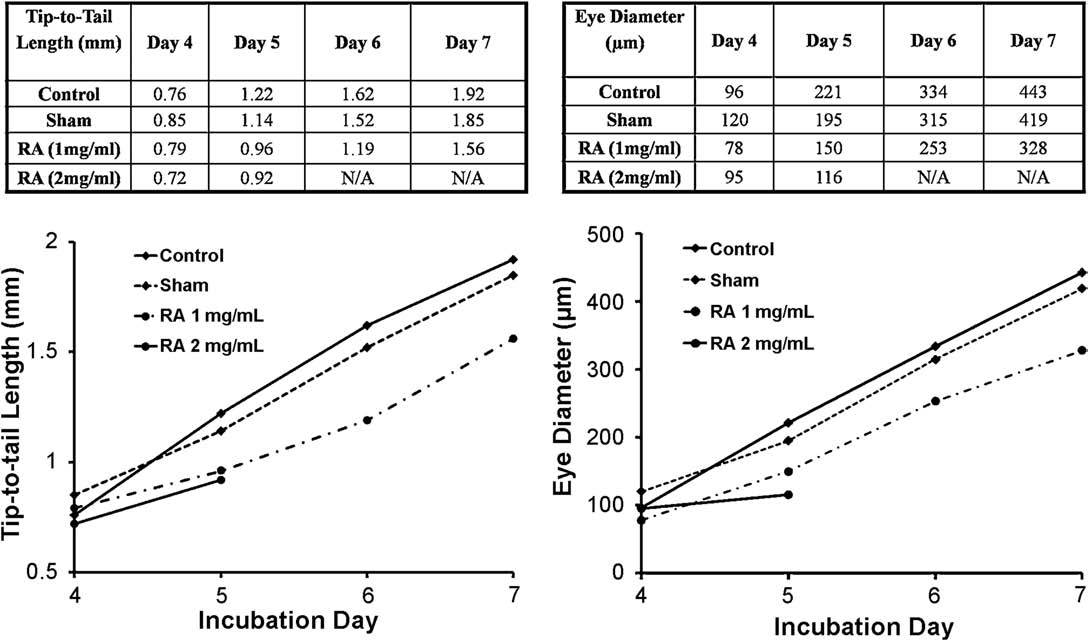
Figure 5. Quantification of eye diameter and tip-to-tail length for retinoic acid perturbation study using open-source software
(ImageJ) provided by the National Institutes of Health.
data. To assist with this task, we recommend that the students plot
2. Are the sham results different from the control? What do the
the data, either digitally or by hand, for each output measured
sham results indicate about our method of treatment?
(Figure 4). Instruct the students to use the data to confirm or deny
• The sham results do not appear to be significantly different
their initial hypothesis. If the hypothesis is confirmed, the students
from the control. This indicates that the defects were not
must prepare a series of arguments from the data to support their
induced by the filter paper or DMSO, but instead can be
claim. If the hypothesis fails, the students must generate a new
wholly attributed to the addition of RA.
hypothesis based on the results of the study. It is also important
3. Approximate the growth rate of each treatment by determining
to consider the implications of these results in a broader context.
the slope of the tip-to-tail curves. Which condition had the
For instance, ask the students how these results might be related
fastest growth rate? Which was the slowest?
to human development, or how the other unmeasured features of
• Control – 0.39 mm/day, Sham – 0.34 mm/day, RA 1 mg/
the embryo, such as the internal organs, might be affected by the
mL – 0.25 mm/day, RA 2 mg/mL – 0.2 mm/day. The con-
trol embryo had the fastest growth rate and the 2 mg/mL RA treatment had the slowest. The control growth rate was
Example Data Analysis & Interpretation Worksheet
roughly twice as fast as the 2 mg/ml RA treatment. This result agrees with the conclusion in question 1, that RA stunted the
Using the generated tables, line graphs, and previous understanding
embryo's growth.
of embryonic development and RA, work through the following
4. From our data, we see that RA treatment affected the global
questions as you analyze the data (Figure 5).
development of the embryo, yet the treatment was applied
1. Compare the tip-to-tail length and eye diameter between the
locally. Why do you think this is?
control and RA treatments. Did addition of RA stimulate or
• Even though the RA is applied over a small area away from
the embryo, it was placed on a blood vessel of the vasculature
• Although the control and treated embryos had roughly the
network. This particular placement on a vessel facilitated the
same starting tip-to-tail length, by day 7 the control tip-to-
spread, and uptake, of RA in the embryo body. This empha-
tail length was 25% greater than the 1 mg/mL RA treatment.
sizes the substantial role the circulatory system plays in nutrient
The 2 mg/mL RA treatment embryo died before day 7. These
consumption and trafficking, demonstrating how high local
results suggest that RA stunted and/or terminated the growth
concentrations of harmful agents can have global consequences
of the embryo.
due to rapid transport throughout the developing embryo.
The american biology Teacher
volume 74, no. 9, november/December 2012
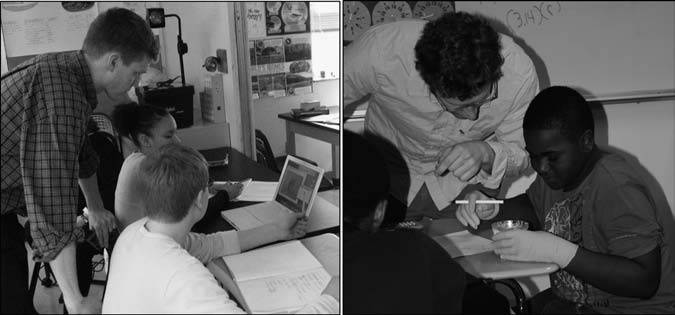
5. Explain how an optimum (not too high and
not too low) human exposure to vitamin A measurement could be determined from these data.
• The upper-bound dosages for human
embryos could be approximated from this study's data by scaling according to body weight or blood volume.
J iscussion
The embryo provides a unique lens through which to study general (cell activity, organ sys-tems) and development-specific (cell differen-
Figure 6. Engagement of students during the ex ovo chick culture and analysis
tiation, morphogenesis) processes in biology
of experimental results.
and physics. Watching the embryo induces fun-damental questioning of why some structures develop first versus later on, how the embryo is feeding itself, and how processes change with growth. Even if it's just in a biology classroom, the effects of physical properties (diffusion, transport, and mechanical forces) can be incor-porated into our lesson framework. Instructional versatility enables the breadth of content to be appropriately scaled to student ability or knowl-edge base. For instance, observation, measure-ment, and prediction of normal development may be sufficient for middle school biology stu-dents, whereas the RA perturbation model may be more appropriate for upper-level high school students. In the following, we present further background information and ethical issues with animal research to extend the applicability of this lesson (Figure 6).
Metabolic & Molecular Aspects of
Study – Mechanism of Action
Figure 7. Metabolic and molecular pathway of retinoic acid (RA) describing the
mechanism through which RA regulates gene regulation (for advanced classrooms).
Vitamin A is broken down into all-trans-RA
and 9-cis-RA, which is then transported to the
nucleus of the cell bound to cytoplasmic RA-binding proteins. Bioethics of Animal Research
Within the nucleus, all-trans-RA binds to RA receptors (RAR) and Using live embryos within the classroom will inevitably spark a con-
9-cis-RA binds to retinoid receptors (RXR). RAR and RXR form RAR/
versation about humane treatment and ethics. We feel that this is an
RXR heterodimers, which bind to regulatory regions of the chromo-
extremely important aspect and should not be overlooked. From a
some called RA response elements (RARE). Binding of all-trans-RA purely regulatory standpoint, all use of vertebrate animals in research, and 9-cis-RA to RAR and RXR respectively allows the complex to teaching, and testing is regulated by the Institutional Animal Care regulate the rate of gene transcription. In the case of all-trans-RA and Use Committee (IACUC, http://www.iacuc.org/). Chick embryos applied systemically to a developing chick embryo, complexity younger than embryonic day 15 (E15) are assumed to be unable to arises because cells and tissues will respond to the RA differently. experience pain, because of limited neural development. It is recom-For example, in the developing limb bud, tissue regression has been mended that E14 or younger embryos be euthanized by hypothermia, largely associated to the molecular control of self-induced cell death typically by placing the eggs in a −20°C freezer. Chick embryos from (apoptosis). Likewise, brain defects have been largely associated E15 to pre-hatching should be euthanized by decapitation, anesthetic to the molecular control of cell migration. Therefore, we suggest agents, or another rapid and humane method. Studies using embryos that a generalized mechanism of action be used for explanation. within 3 days of hatching or hatchlings must be reviewed by the normal Upon excess RA administration, stunted growth may be the result IACUC procedure for vertebrate animals. In our experiments, embryos of abnormal cell migration or apoptosis, which is regulated directly will be euthanized at day 7, which is only one-third of the way through by the transcriptional complex (RA and 9-cis-RA to RAR and their 3-week hatching cycle. Therefore, the embryos cannot experience RXR) (Figure 7, adapted from http://lpi.oregonstate.edu/infocenter/ pain and are exempt from any IACUC protocols. This, however, will vitamins).
not limit conversation about the ethics of animal research within the
The american biology Teacher
embryonic morPhogeneSiS
classroom. We encourage teachers to lead a classroom discussion on
lanska, D.J. (2010). chapter 29: historical aspects of the major neurological
the role of animals in scientific research and use this time effectively to
vitamin deficiency disorders: overview and fat-soluble vitamin a.
discuss humane treatment and ethics. From our experience, the level
Handbook of Clinical Neurology, 95, 435–444.
of concern and opinions will vary from class to class. It is imperative to
ritchie, h.e., brown-Woodman, P.D. & Korabelnikoff, a. (2003). effect of
gauge student sensitivity in a considerate and objective manner before
co-administration of retinoids on rat embryo development in vitro. Birth Defects Research A, 67, 444–451.
conducting the experiments. Resources for animal research ethics can
rothman, K.J., moore, l.l., Singer, m.r., nguyen, u.S., mannino, S. & milunsky,
be found on the Web at http://www.ethics.org.
a. (1995). Teratogenicity of high vitamin a intake. New England Journal of Medicine, 333, 1369–1373.
yalcin, h.c., Shekhar, a., rane, a.a. & butcher, J.T. (2010). an ex-ovo
chicken embryo culture system suitable for imaging and microsurgery
This work was supported by the National Science Foundation
applications. Journal of Visualized Experiments, 44, e2154.
Graduate STEM Fellows in GK-12 Education (GK-12) Program
Zile, m.h. (2010). vitamin a – not for your eyes only: requirement
(grant no. DGE0841291).
for heart formation begins early in embryogenesis. Nutrients, 2, 532–550.
PhiliP r. buSKohl is a graduate Student in biology at cornell university,
ackermans, m.m., Zhou, h., carels, c.e., Wagener, F.a. & von den hoff, J.W.
ithaca, ny 14853; e-mail: [email protected]. ruSSell a. goulD is a
(2011). vitamin a and clefting: putative biological mechanisms. Nutrition
graduate Student in biology at cornell university; e-mail: rag237@cornell.
Reviews, 69, 613–624.
edu. SuSan curran is a biology Teacher at elmcrest children's center,
Davey, m.g. & Tickle, c. (2007). The chicken as a model for embryonic
Syracuse, ny 13324; e-mail: [email protected]. Shivaun D. archer is a
development. Cytogenetic and Genome Research, 117, 231–239.
Senior lecturer in biology at cornell university; e-mail: [email protected].
Dolk, h., loane, m. & garne, e. (2010). The prevalence of congenital anomalies
JonaThan T. buTcher is assistant Professor of biology at cornell university;
in europe. Advances in Experimental Medicine and Biology, 686, 349–364.
e-mail: [email protected].
Edited by Beatrix Beisner, Christian
Messier, and Luc-Alain Giraldeau
"This is an easily accessible first look at
ecology on your doorstep. . It provides a
means to develop basic literacy in this
important, timely area of science."
Nina Bassuk, Cornell University
PAPER $18.00
The University of Chicago Press
The american biology Teacher
volume 74, no. 9, november/December 2012
Appendix. Addressing the National Science Education Standards.
Value of This Activity
Teachers should successfully convey
Students will successfully design, conduct, report and evaluate the
unifying concepts of science.
effects of RA on embryonic development. Using mathematics, students will process and report data to understand the origin of congenital defects through environmental factors.
Teachers should engage students in
During our investigation, we implement multiple methods of inquiry
various methods and active learning
leading to scientific knowledge. Students determine the effects of RA
through scientific inquiry.
on embryonic development that require them to develop concepts and relationships from their observations, data, and inferences in a scientific manner.
Teachers should organize safe and
Students will treat all living organisms used in the classroom or found
effective learning environments that
in the field in a safe, humane, and ethical manner and respect legal
promote the success of students and the restrictions on their collection, keeping, and use. Classroom discussions welfare of all living things.
on using animals for experimental systems have been highlighted.
Teachers should create a community of
The experiments have been organized to engage students in a
diverse learners who construct meaning
collaborative learning environment. In addition, technological tools such
from their science experiences for further as ImageJ allow students to collect and process data and facilitate the exploration and learning.
learning of science.
The american biology Teacher
embryonic morPhogeneSiS
Source: http://abt.ucpress.edu/content/ucpabt/74/9/636.full.pdf
bharatividyapeethuniversity.net
Bharati Vidyapeeth Deemed University, Pune (India) ‘A' GRADE AWARDED BY GOVT. OF INDIA ‘A' GRADE REACCREDITATION BY NAAC Amongst India's Best Law Schools INFORMATION BROCHURE AND APPLICATION FORM OF ENTRANCE TEST LL.B. 2014 For Admission to B.B.A. LL.B. 5 YEAR COURSE At BHARATI VIDYAPEETH DEEMED UNIVERSITY NEW LAW COLLEGE, PUNE (Estd. 1978)
May 2008 newsletter.cdr
THE SPRUCE LODGE HOME AUXILIARY The Spruce Lodge Home Auxiliary was at BBQ's, run Bingo parties and other programs initiated in 1965. This group of committed and caring including gardening, baking and crafts. They ran our women has been serving our residents now for over 43 tuck shop, sharing a cup of tea and kind words with years and hope to be around for many years to come.